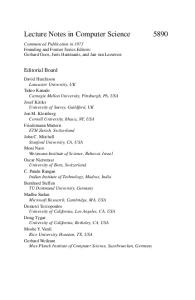Computational materials science
- PDF / 33,291 Bytes
- 1 Pages / 612 x 792 pts (letter) Page_size
- 114 Downloads / 422 Views
JPEDAV (2004) 25:110 DOI: 10.1361/15477020419091 1547-7037/$19.00 ©ASM International
Computational Materials Science At Iowa State University we recently (Fall 2003) held a large symposium celebrating the 100th anniversary of the birth of John V. Atanasoff and the invention of the first electronic digital computer (∼1939). Of course there were many reflections on the history of scientific computing. Atanasoff was a physics professor who had obtained his Ph.D. with John VanVleck calculating the polarizability of a helium atom using the new theory called quantum mechanics in 1929. By 1939 his students were going after more complicated problems and Atanasoff realized something had to be done to overcome the huge bottleneck caused by ever growing numerical/computational effort. At the symposium there were also speakers telling about recent progress and future visions. It is clear that as the various scientific communities focus on climate modeling, nano-science and engineering, bioinformatics, and a whole host of new material systems, we are still pushing the limits and facing bottlenecks in computing. But what amazing progress has been made! How will the future look? One approach is ever bigger investments in huge facilities, such as the recent $500M Japanese computational science investment centered around the world’s largest supercomputer (the Earth Simulator). This is similar to large national investments in experimental facilities such as particle accelerators, photon and neutron sources, and most recently, nano-centers. Many visionaries have suggested that computational science has progressed so rapidly that it now constitutes a third pillar to science along with experiment and theory. Indeed, the new computational facilities are an indication of the increased importance of modeling and simulations. For materials science, there are many opportunities for the development of new computational tools that will take advantage of these facilities. Multi-scale modeling, dynamical mean field theory, fracture dynamics, phase transitions, self-organization, bio-inspired materials, non-equilibrium structures, spintronics, and photonics are just a few of the topics being pursued. More and more interdisciplinary teams are forming to go after these important problems, and it is gratifying to see computer scientists joining these teams. An end to small science? No. But maybe a beginning of bigger science for a field that is rapidly growing in importance.
Bruce Harmon Associate Editor Journal of Phase Equilibria and Diffusion
110
Journal of Phase Equilibria and Diffusion Vol. 25 No. 2 2004
Data Loading...











